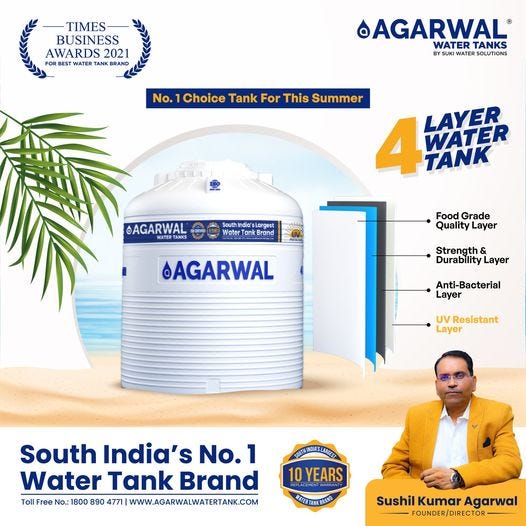Water Tank 1000 Ltr Price: A Comprehensive Guide

Choosing the right water tank for your home or business is a crucial decision that impacts your daily water storage and usage. A 1000-liter water tank is a popular choice for many households due to its adequate capacity and manageable size. In this comprehensive guide, we’ll explore everything you need to know about the pricing of 1000-liter water tanks, including factors affecting the price, types of water tanks, and tips for choosing the best tank for your needs.
Types of 1000-Liter Water Tanks
1. Vertical Water Tanks
Vertical water tanks are cylindrical and stand upright. They are ideal for locations with limited ground space and provide a high storage capacity without occupying much area. These tanks are commonly used for domestic water storage.
2. Horizontal Water Tanks
Horizontal water tanks are designed to lie flat on the ground. They are suitable for installations where height restrictions apply or where the tank needs to fit under structures. These tanks are often used in commercial and industrial settings.
3. Loft Water Tanks
Loft water tanks are compact and designed to fit in tight spaces like lofts or attics. They are typically used for indoor water storage and are a great option for homes with limited outdoor space.
4. Underground Water Tanks
Underground water tanks are buried beneath the ground, offering a discreet and space-saving solution. They are perfect for properties with limited surface area and can be used for rainwater harvesting and emergency water storage.
Price Range of 1000-Liter Water Tanks
The price of a 1000-liter water tank can vary widely based on the factors mentioned above. Here is a rough estimate of the price range for different materials:
- Plastic (Polyethylene): $100 — $300
- Stainless Steel: $500 — $1000
- Concrete: $800 — $1500
- Fiberglass: $400 — $800
Please note that these prices are indicative and can vary based on the brand, features, and region.
Understanding the Factors Affecting Water Tank Prices
Several factors influence the price of a 1000-liter water tank. Here are the key elements to consider:
1. Material
Water tanks are made from various materials, each with its own cost implications:
- Plastic (Polyethylene): These tanks are lightweight, durable, and cost-effective. They are resistant to corrosion and easy to install, making them a popular choice.
- Stainless Steel: Known for their strength and longevity, stainless steel tanks are more expensive than plastic tanks. They are ideal for storing potable water due to their resistance to rust and contaminants.
- Concrete: These tanks are extremely durable and suitable for large-scale water storage. However, they are heavier, require professional installation, and come at a higher price point.
- Fiberglass: Offering a good balance between strength and weight, fiberglass tanks are resistant to rust and chemical damage but can be more expensive than plastic tanks.
2. Brand and Manufacturer
The brand and manufacturer can significantly influence the price of a water tank. Renowned brands with a reputation for quality and reliability often charge more for their products. Investing in a well-known brand can provide peace of mind regarding durability and performance.
3. Features and Specifications
Additional features and specifications can also affect the price:
- UV Protection: Tanks with UV protection prevent the growth of algae and degradation of the tank material due to sunlight exposure.
- Insulation: Insulated tanks help maintain the temperature of the stored water, which is particularly useful in regions with extreme weather conditions.
- Design and Color: Some tanks come in various colors and designs to blend with your property’s aesthetics. Custom designs and colors can increase the cost.
4. Installation and Accessories
The cost of installation and any additional accessories required, such as stands, pipes, and fittings, should be considered. Some manufacturers include installation in the price, while others may charge extra.
Tips for Choosing the Right 1000-Liter Water Tank
1. Assess Your Needs
Determine the primary purpose of the water tank. Are you storing potable water, rainwater, or water for irrigation? Understanding your needs will help you choose the right material and type of tank.
2. Check for Certifications
Ensure that the water tank meets local regulations and standards for water storage. Look for certifications from relevant authorities to guarantee the quality and safety of the tank.
3. Compare Brands and Reviews
Research different brands and read customer reviews to get an idea of the tank’s performance and durability. Opt for reputable brands with positive feedback from users.
4. Consider Maintenance
Some materials require more maintenance than others. For instance, stainless steel tanks may need periodic cleaning to prevent rust, while plastic tanks are relatively low-maintenance. Factor in the long-term maintenance requirements when making your decision.
5. Plan for Installation
Consider the space available for installation and the accessibility of the location. Ensure that the chosen tank fits the designated area and that the installation process is feasible.
6. Budget Wisely
While it’s tempting to go for the cheapest option, investing in a quality tank can save you money in the long run. A durable and well-constructed tank will last longer and require fewer repairs or replacements.
Conclusion
A 1000-liter water tank is an excellent investment for ensuring a reliable water supply for your home or business. By understanding the factors that affect the price, the types of tanks available, and the tips for choosing the right tank, you can make an informed decision that suits your needs and budget. Whether you opt for a plastic, stainless steel, concrete, or fiberglass tank, the key is to prioritize quality and suitability for your specific requirements.
Comments
Post a Comment